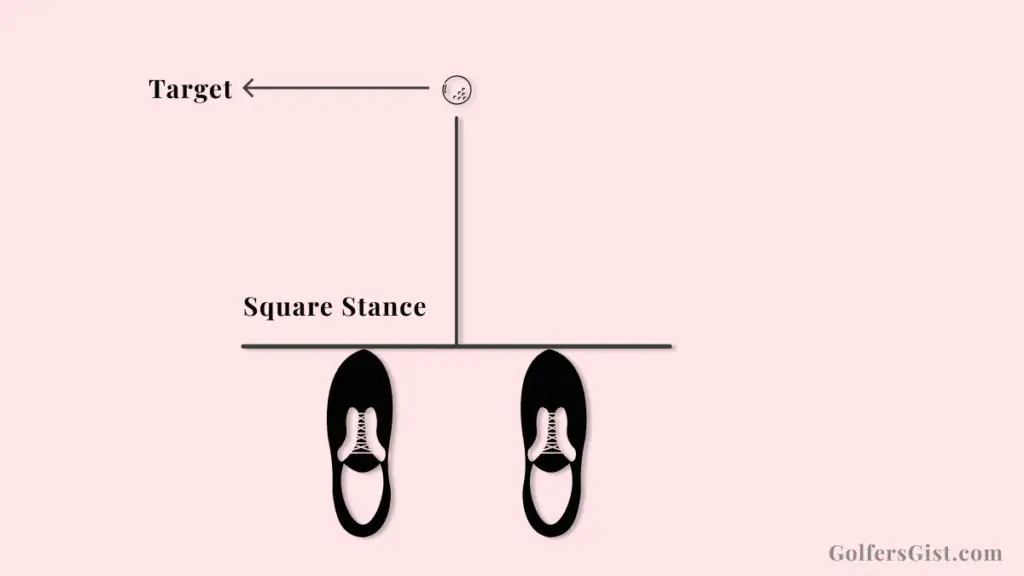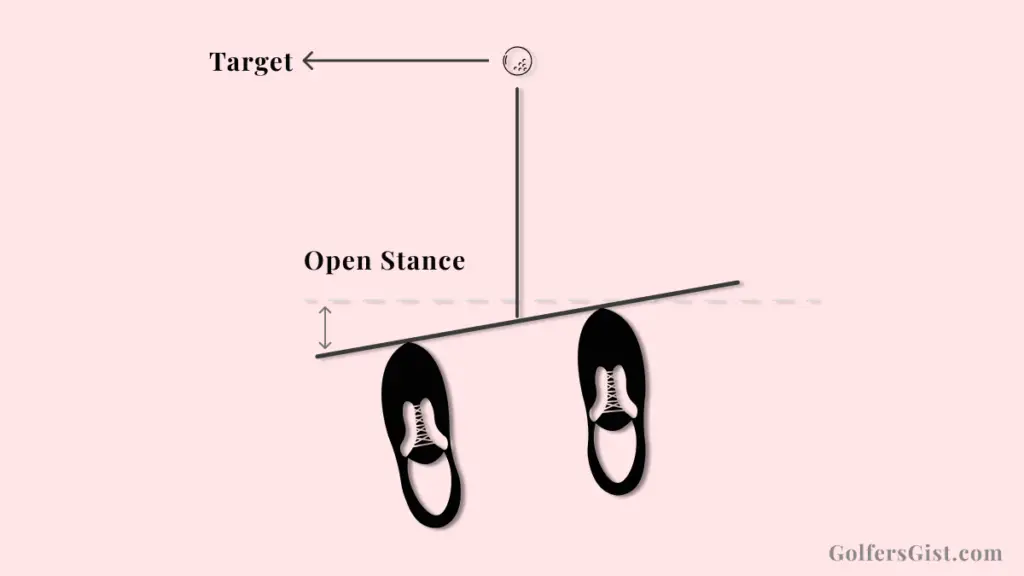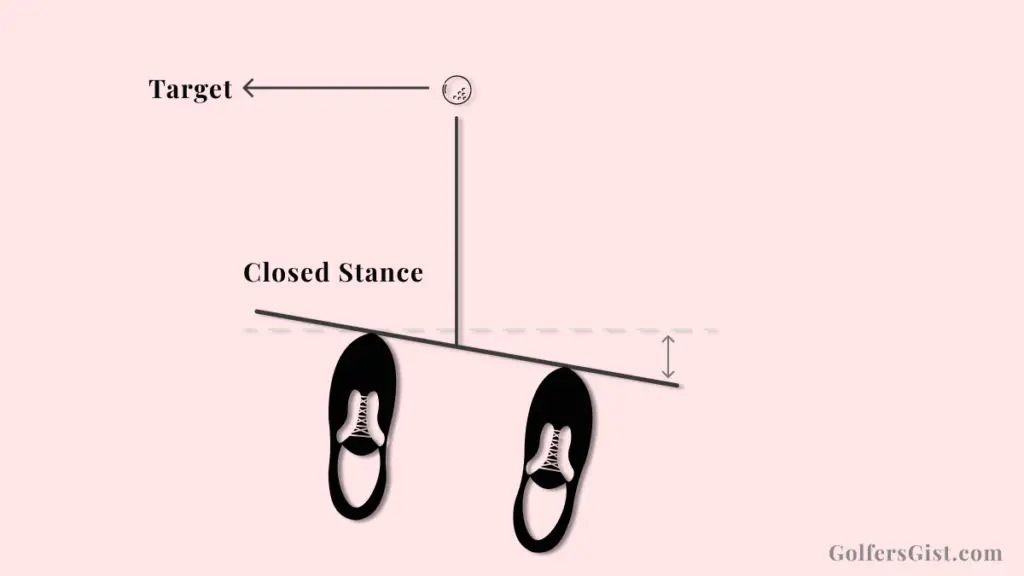In this Article
This unbiased guide analyzes the debated benefits of a square stance for golf. Learn how a squared setup can promote an efficient inside-out swing path for straighter shots and evaluate whether implementing this technique could improve your consistency. I objectively assess the advantages of a square stance vs. open or closed alignments to help determine the best foot position for your swing.
The concept of a square stance in golf has been debated amongst players and instructors for years. A square stance refers to positioning your feet parallel to the target line, with the toe line of each foot running perpendicular to that target line. But is mastering a square setup essential for success on the course, or is it an overrated myth in the world of golf instruction?
In this article, I’ll provide an impartial look at the potential benefits and drawbacks of using a square stance. My goal is to give you an honest, practical guide so you can determine if a square stance could be a game-changer for your golf swing or if you’re better off sticking with your natural foot alignment.
First, I’ll define what exactly a square stance entails and how it contrasts from open and closed stances. Then, we’ll analyze the proposed advantages of a square stance, from promoting a consistent swing path to improving balance and power. I’ll also cover common mistakes players make when attempting a square stance and compare its merits to other options like an open or closed stance.
While a square stance may offer advantages for some golfers, especially beginners, it isn’t necessarily the ideal alignment for everyone. Some players may benefit more from a stance that fits their body type and swing mechanics. My aim isn’t to present the square stance as a one-size-fits-all solution. Rather, I want to provide an unbiased look at the real impacts it can have so you can determine if incorporating this technique could be beneficial or not for your game.
By the end of this article, you’ll have a clear understanding of the square stance and whether or not you should consider integrating it into your setup. With an open mind and some experimentation, you may just find that a square stance is a game-changing secret to consistent, powerful ball-striking. Or, you may discover an alternative stance better suited to your swing. Either way, you’ll gain valuable insight into your alignment and ball position in order to take your golf game to the next level.
Table of Contents
What is a Square Stance?
When it comes to golf setup, a square stance is one of the most commonly referenced foot alignments. But what exactly constitutes a square stance?

To achieve a square stance, you’ll want to position your feet shoulder-width apart with your toes pointed straight ahead. Imagine a line extending from the golf ball that runs to your target. Now visualize another line extending perpendicular from that target line, directly between your toes. The goal is to get these two imaginary lines parallel to each other.
Specifically, you’ll want your toe line, and even better your heel line, to align parallel to the target line. Rotate your feet until they are squared up evenly. Keep your weight balanced and distributed evenly between both feet as well. Maintain a comfortable knee flex to avoid locking up.
Setting up with a square stance contrasts from an open or closed stance. With an open stance, your toe line will point behind the golf ball, crossing the target line. A closed stance has your toe line crossing in front of the target line instead.
A square setup is considered the “standard” for beginning golfers. By keeping your feet and clubface aligned parallel to the target, you start the swing on the proper path for solid contact. An inside-square-inside swing path promotes a straight, controlled ball flight.
Some players may need to make slight adjustments, opening or closing their stance slightly based on factors like slope or shot shape. But a square setup is the go-to foundation before any modifications. Take care to avoid common mistakes like standing too far from the ball or angling your feet too much open or closed. Start from a neutral, balanced square stance.
With a bit of practice, setting up in a square alignment can become second nature. Pay attention to properly positioning your feet at address, keeping toes and knees straight ahead. Aim down the target line from this squared stance to give your swing the best chance of repeating itself.
Benefits of a Square Stance
Using a square stance in your golf setup comes with a variety of potential benefits. While a squared alignment may not be ideal for every player, understanding the possible advantages can help you determine if this technique is worth incorporating into your game.
Promotes an Inside-Square-Inside Swing Path
The main upside of a square stance is promoting an inside-square-inside swing path. With your feet aligned parallel to the target line, the club can swing straight back and straight through on plane. This inside path creates pure ball striking with a straight ball flight and minimal sidespin.
Improves Shot Shaping and Trajectory Control
The lack of sidespin makes it easier to control your shot shape and trajectory. Without imparting unintentional slice or hook spin, you can better direct each shot precisely where you want it to go. Your misses will come more often from mishits rather than curves, meaning you stay in play more frequently.
Provides a Consistent Foundation for Beginners
For beginners especially, a square stance provides a reliable foundation to build a swing on. Starting here gives your body a neutral base, making it simpler to return the club to impact from the proper approach. As you develop swing mechanics, this base alignment engrains good setup habits.
Enhances Balance, Stability, and Consistent Contact
A square stance can also enhance balance, stability, and consistent contact. With your weight evenly distributed and feet firmly grounded, you reduce swaying that throws off the swing rhythm. This centered posture improves rotation for added power as well. Your improved foundation leads to making a cleaner impact with the golf ball.
Reduces Injury Risk
The balance and stability from a square stance additionally minimize injury risk. Your body stays aligned to handle the rotational forces generated during the swing. You’ll reduce strain on joints and muscles by keeping them in a proper position.
Leads to More Consistent Ball-Striking
All these benefits combine to lead to more consistent ball-striking. Your shots lose less distance and direction from mishits when you swing from a solid, neutral base. As your misses decrease, your scoring drops accordingly. A square stance helps to optimize your efficiency and effectiveness for lower scores.
Of course, a square stance in itself cannot cure every golf struggle. Proper mechanics overall are still essential. But by realigning your feet at setup, you give your swing a biomechanical advantage to deliver the club correctly. Take the time to practice this technique and enjoy the advantages it can create.
Implementing a Square Stance
Now that you understand the benefits of a square stance, let’s cover the proper way to set up this alignment. While a simple concept, in theory, executing a squared stance takes some practice. Follow these tips for achieving a proper square setup.
Setting Stance Width
The first key is positioning your feet about shoulder-width apart. Turn them both outward until they are parallel. You want your stance neutral, not too narrow or excessively wide. approximate the width between your shoulders as a starting point.
Aligning Feet to Target
Once your feet are shoulder-width, envision a line from the ball to your target. Now rotate your feet until the toes align perpendicular to this target line. Focus on getting your toe line, or even better your heel line, parallel to the target line.
Maintaining Proper Posture
Keep your knees slightly flexed and weight balanced evenly after aligning your feet. Avoid locking knees or leaning. This athletic posture allows coiling back and through the swing. Stay grounded without swaying side to side.
Positioning the Golf Ball
Ball position varies based on club selection and desired shot shape. But a general rule is to align it opposite your left heel for the driver, moving it forward toward the center with shorter clubs. Adjust from there based on slope, wind, etc.
Rechecking Alignment
After setting up, recheck your alignment to verify feet remain parallel to the target line. Use reference points behind the ball to double-check your toe line. Have a training aid like an alignment stick handy as well.
Adjusting Stance if Needed
You may need to open or close your stance slightly based on the shot. But start from a square base first, then make minor changes. Don’t over-adjust your feet alignment.
Setting up square every shot can feel awkward initially. But with practice, this fundamentally sound alignment will become natural. Ingrain the habit of checking your toe line before settling in and swinging. Proper setup promotes consistency for better ball striking.
Common Mistakes With Square Stance
Standing Too Far From the Ball
A common mistake is teeing up or placing the ball too far back in your stance. This makes it hard to make consistent contact and often leads to hitting behind the ball. Make sure to set up with the ball aligned with your left heel for the driver.
Getting Too Close to the Ball
The opposite issue is standing too close to the ball at address. This crowds your swing and prevents a full turn. Give yourself proper space based on club length to avoid this mistake.
Stance Too Narrow
Setting your feet too close together reduces stability and balance. Your shoulder-width stance will feel narrow at first. Resist closing your stance extremely when squaring up into a narrow golf stance.
Stance Too Wide
A stance too wide open causes tension and discomfort. It also encourages swaying rather than turning. Use your shoulders as a gauge for proper width.
Feet Not Aligned Properly
Failing to rotate your feet fully to align perpendicularly with the target line defeats the purpose of a square stance. Take care to angle feet correctly.
Over-Rotating Feet
Rotating feet too far can lead to an open or closed stance. Use small adjustments once your feet are square as a baseline.
Difficulty Maintaining Square Stance
You may struggle keeping feet aligned throughout the swing. Check setup again if you lose your footing. Proper balance and rotation will improve this.
Setting up a square requires precision and practice. Be attentive to your address position and make corrections as needed. Patience and repetition will help correct errors until a square stance becomes comfortable.
Square Stance vs. Open and Closed Stances
While a square stance is considered the standard setup position, golfers also commonly use open and closed stances. How do these alignments differ from a square look? When might an open or closed stance be preferential?
Defining Open and Closed Stances
First, let’s define what characterizes an open versus closed stance:
An open stance refers to positioning your feet aimed left of the target line. Your toe line will point behind the golf ball rather than being perpendicular to the target like a square stance. This stance “opens” your body relative to the target.

Conversely, a closed stance has your toe line angled right of the target line, pointing in front of the ball. Your feet are closed off relative to the target with this alignment.

Both open and closed stances change the relationship between your clubface, feet, and intended target line at address. This contrast creates different ball flights.
Impacts of Open and Closed Stances
When opening your stance, it works to open the clubface as well. The added loft created from this setup produces higher, softer shots that land gently. An open stance also promotes drawing the ball from left to right.
Closing your stance has the opposite effect. The clubface becomes relatively closed, lowering loft and inducing right-to-left shot shapes. Closing your feet aims momentum left, facilitating fades and low runners.
Comparing to Square Stance
Unlike a square stance, open and closed alignments impact shot shape and trajectory. While square promotes neutral ball flight, open and closed stances intentionally influence shot patterns.
The directional nature of open/closed stances also makes them more challenging for beginners to control. The square stance’s neutral ball flight is more forgiving and easier to manage.
However, skilled players manipulate open and closed stances for shaping shots. An open stance can increase loft on an approach or tee shot for example. Closing the stance helps shape tee shots from right to left around a dogleg.
The centered balance and rotational ease of a square stance may also be advantageous for some players versus angled foot alignments. But this depends on individual comfort level and biomechanics.
Determining Which Stance to Use
The situation and desired shot shape dictate whether an open, closed or square stance is appropriate. While square is suitable in many cases, being proficient in all three is beneficial.
Use an open stance when you need a higher soft shot or draw shape. Close your stance to hit controlled fades or low shots. Square works well for straight shots with neutral trajectory.
Ideally, start with a neutral square stance as your baseline. Then make small adjustments as needed based on target and trouble. Mastering all three approaches provides versatility for dealing with any golf scenario.
Should You Use Square Stance?
With the fundamentals of the square stance covered, should you implement this technique into your own golf game? Here are some factors to consider when deciding if a square setup is right for you.
Ultimately, there is no definitive answer on whether all golfers need a square stance. The ideal alignment depends on your existing swing mechanics and performance goals.
For example, beginners may benefit greatly from the consistency and ease of a square stance. But golfers who already deliver the club successfully may not need to alter their footing.
Before abandoning your current stance, experiment with a squared alignment during practice sessions. Try it for a full-range bucket or a few rounds. Compare your ball-striking and shot patterns versus a normal stance.
Pay attention to factors like contact consistency, distance control, shot shaping, and dispersion. If you see noticeable improvements in these areas with a square setup, it likely warrants adopting. But if performance declines or feels off, you may prefer your natural foot alignment.
Don’t be afraid to get creative with your experiments too. Try a slightly open or closed version of a square stance if a neutral alignment doesn’t suit you. The goal is to find an approach that enhances your swing, not forcing an unnatural fit.
If unable to determine the optimal stance after self-testing, don’t hesitate to work with a PGA professional. An experienced instructor can analyze your swing and recommend the best setup modifications.
Regardless of which stance you adopt, dedicating practice to ingrain position and alignment is key. Changing habits requires repetition for muscle memory. Be patient and focus on proper setup position through the learning process.
Analyze your swing goals and mechanics, then test options to find what works best. With an informed, tailored approach, dialing in proper stance alignment can provide a solid foundation for golf success.
Conclusion
In closing, a square stance can be an effective technique for some golfers but may not suit every player’s style. There are benefits to aligning your feet parallel to the target line, but it is not required to play quality golf.
The core question around square stance is if it can help enhance your consistency and ball striking. For certain players, especially beginners, setting up squarely does provide a biomechanical advantage. The stance can promote an efficient swing path and neutral ball flight when executed properly.
However, a square stance does not universally work for every body type and swing. Some players align and rotate better from an open or closed stance instead. Factors like flexibility, strength, posture, and more impact what setup works optimally.
Rather than taking a rigid view that a square stance is absolutely necessary, focus instead on what creates consistency and comfort in your own swing. Experiment with different alignments during practice to see what setup lets you strike the ball crisply and control direction.
While proper stance alignment is important, no single style or element alone dramatically lowers scores. Striving for a comfortable, repeatable setup that lets your body swing freely matters most. Keep an open mind to find what works best for you, whether it’s a wide vs. narrow golf stance.
In the debate about whether square golf stance is a myth or a game-changer, the answer depends on the individual. Test for yourself if a square look improves your driving, iron play, and consistency. But also realize that standing a bit open or closed is not necessarily a flaw if you swing well.
Optimizing your unique setup and stance for repeatability gives your swing its best chance to perform. Keep learning and experimenting to become your own best coach.

